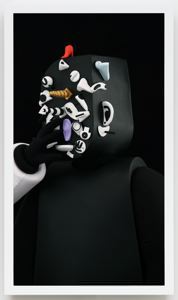Brian Bress
(Norfolk, Virginia, 1975 - )
Organizing The Physical Evidence (all white, all black)
2018
High definition dual-channel video (color), two high definition monitors and players, wallmounts, framed
39 1/2 x 49 x 3 1/4 in. (100.3 x 124.5 x 8.4 cm)
Collection of the Akron Art Museum
Museum Acquisition Fund
2018.13 b
More Information
Humor and playfulness are embedded within the slow, deliberate movements of Bress’ figures, which feel familiar—a combination of cartoon- and puppet-like beings. They seem approachable, yet there is no interaction with the viewer—they are hermetically sealed behind glass in repeating 15-30 minute loops. The figures are detached from time and place, existing only on and for the screen. In Brian Bress’ series of diptychs titled 'Organizing the Physical Evidence', two figures blindly adorn their heads with only their touch to guide them.Bress’ characters affix physical objects, which the artist sculpted out of clay and then cast in plastic, to each other’s heads in a presumed attempt to create a face. The viewer is privy to the entire process, while the artist himself works methodically under a mask with no eye holes. It is a fumbling, imperfect process. The gloved figures are clad in opposing black and white costumes inspired by the toy-like geometric costumes designed by German Bauhaus artist Oskar Schlemmer for his Triadic Ballet in 1922. They grab forms—some of which resemble facial features, while others are abstract—and reach up to place them on their faces and heads. Fleeting impressions of faces appear until more elements are added, jumbling the arrangements into studded abstract sculptures. Curiously, the unseeing figures turn toward each other every so often, as if to model their newly-formed faces to each other. Bress’ move to allow the viewer to bear witness to a process that he himself cannot see is a fascinating and generous artistic act that can be seen as paradoxically transparent. Another element of generosity in the work is that the two figures literally give of themselves—they humbly pluck elements from their own heads and reach across screens to place them on each other, as if to say, “Maybe this piece will work for you.” The net effect of these blind and unspoken acts of communication is a beautiful, philosophical and humorous reflection on the idea of what constitutes a being.
Keywords
HumorVideo
Media Art
Costume
Masks

